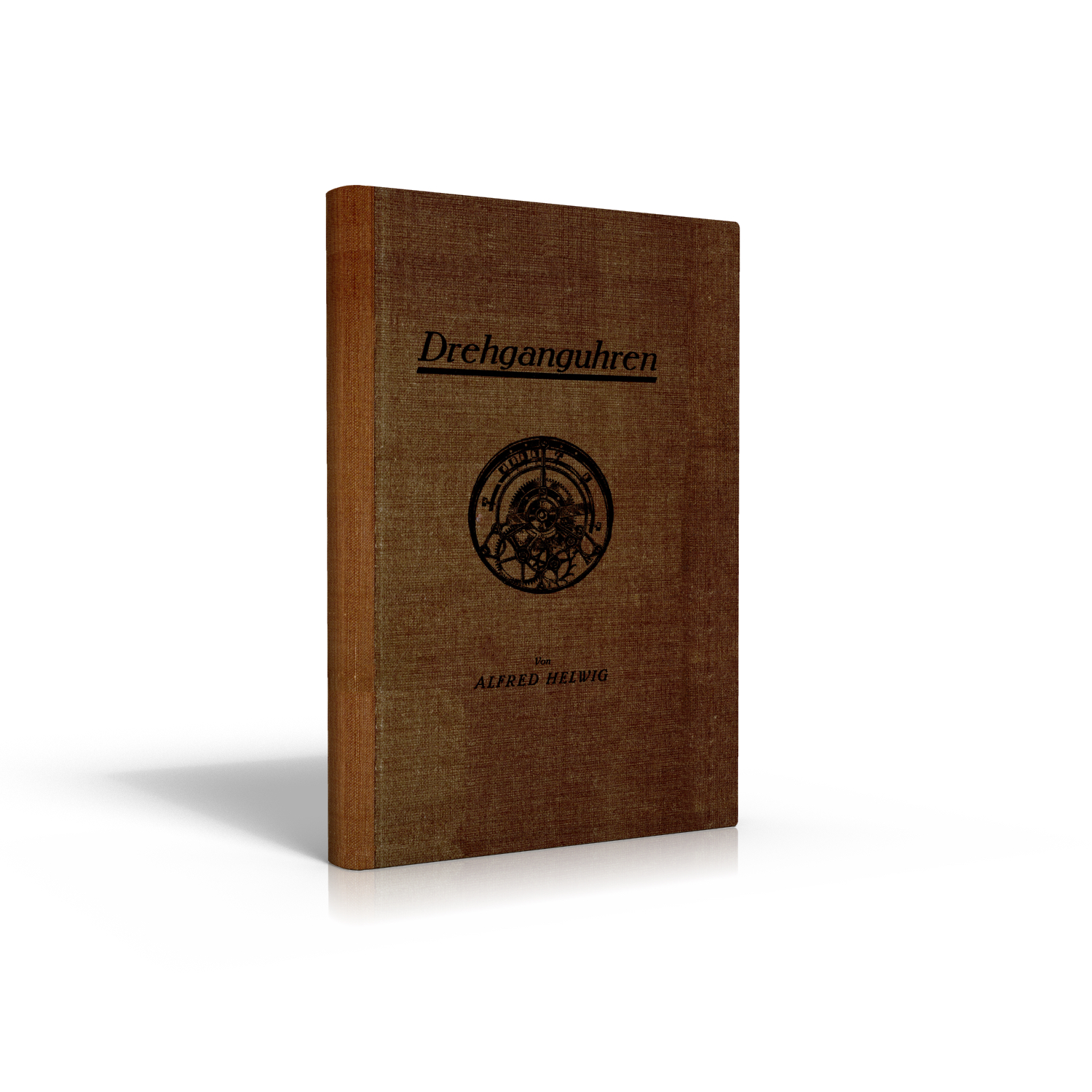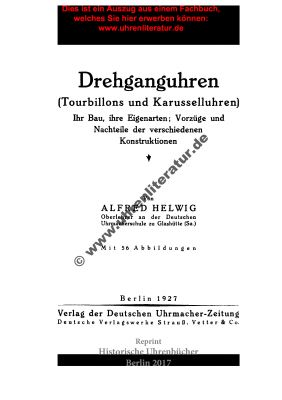

Drehganguhren (book by Alfred Helwig)
Product number:
341309
Packaging Unit:
1
the delivery time is approx. 2 more weeks.
Downloads
| Article name: | Tourbillions |
|---|---|
| Content: | 104 |
| Special feature: | DREHPENDELUHREN |
| Unit content: | pages |
Manufacturer Informations
Name: Florian Stern
Street: Sternwartestr. 17a
City: 6020 Innsbruck
Country: AT
Email: bestellung@uhrenliteratur.de
Phone: 0049 (0)30 83203842
0 of 0 reviews
Login
No reviews found. Be the first to share your insights.
Product information "Drehganguhren (book by Alfred Helwig)"
Book title: Drehganguhren
Author: Alfred Helwig
ISBN: 978-3-939315-54-4/9783939315544
Facts: 1926, Reprint Berlin 2017, 104 p./56 illustrations, A5 format, hardcover
Book about the tourbillion
With this book, Alfred Helwig has finally brought clarity to the tourbillion debate. He presented and differentiated the individual construction types in order to present the tourbillion construction of the German School of Watchmaking and the regulation of the tourbillion. This book is one of the most important books on the topic of tourbillions.
"In 1922, Helwig 's finished his own tourbillon, with which he passed his master examination, late due to the war interruption. It had a circulation time of five minutes, an anchor escapement, and two barrels connected in series. Helwig had set out the concept of the five-minute tourbillon with two barrels, built on the principle of the third wheel, in detail in this book in 1927. The raw movement for this watch, which bore the school number 3022, was made Helwig's student, Edgar Simmchen. This was possible because not the entire clock, but the complete bogie. including the anchor escapement, was defined as the masterpiece; only that component had to be produced by Helwig himself." (adapted from Fritz von Osterhausen, Klassik Uhren 5/99, p. 18)
About the Author, Alfred Helwig (DOB 05/07/1886; † 18/05/1974)
Alfred Helwig was a German precision watchmaker and specialist author, as well as the inventor of the flying tourbillon.
From 1900, he completed a watchmaking apprenticeship in Sorau with the master watchmaker Gustav Dunkel, before he attended the German School of Watchmaking in Glashütte from 1904 to 1905. He then worked with Georg Braun in Hof. 1906 he was hired in the Glashütter Präzisions-Uhren-Fabrik A.G., and from 1908 he worked at Hamburg Chronometerwerken. In 1909, he returned to Glashütte and worked at the Glashütter Präzisions-Uhren-Fabrik A.G. until 1911.
In 1911, he opened his workshop for chronometry in Glashütte. From 1 April 1913 to 1944, Helwig worked as a subject teacher at the German School of Watchmaking in Glashütte. In 1923, he was appointed a senior teacher, and in 1933 received the title of trade lecturer. In 1937, Helwig was entrusted with development and research tasks, and the care of students was no longer part of his duties; thus ended the production of the famous Helwig student tourbillons at the GSW. In October 1954, he ended his work at the German School of Watchmaking in Glashütte.
He specialised in fine tuning and tourbillons. In the 1920s, he developed a flying tourbillon, which was also produced by several of his master students under his guidance. This flying tourbillon was first realised in 1920 by Helwig in collaboration with his master student, Conrad Richter. (taken and translated from Wikipedia)
Author: Alfred Helwig
ISBN: 978-3-939315-54-4/9783939315544
Facts: 1926, Reprint Berlin 2017, 104 p./56 illustrations, A5 format, hardcover
Book about the tourbillion
With this book, Alfred Helwig has finally brought clarity to the tourbillion debate. He presented and differentiated the individual construction types in order to present the tourbillion construction of the German School of Watchmaking and the regulation of the tourbillion. This book is one of the most important books on the topic of tourbillions.
"In 1922, Helwig 's finished his own tourbillon, with which he passed his master examination, late due to the war interruption. It had a circulation time of five minutes, an anchor escapement, and two barrels connected in series. Helwig had set out the concept of the five-minute tourbillon with two barrels, built on the principle of the third wheel, in detail in this book in 1927. The raw movement for this watch, which bore the school number 3022, was made Helwig's student, Edgar Simmchen. This was possible because not the entire clock, but the complete bogie. including the anchor escapement, was defined as the masterpiece; only that component had to be produced by Helwig himself." (adapted from Fritz von Osterhausen, Klassik Uhren 5/99, p. 18)
About the Author, Alfred Helwig (DOB 05/07/1886; † 18/05/1974)
Alfred Helwig was a German precision watchmaker and specialist author, as well as the inventor of the flying tourbillon.
From 1900, he completed a watchmaking apprenticeship in Sorau with the master watchmaker Gustav Dunkel, before he attended the German School of Watchmaking in Glashütte from 1904 to 1905. He then worked with Georg Braun in Hof. 1906 he was hired in the Glashütter Präzisions-Uhren-Fabrik A.G., and from 1908 he worked at Hamburg Chronometerwerken. In 1909, he returned to Glashütte and worked at the Glashütter Präzisions-Uhren-Fabrik A.G. until 1911.
In 1911, he opened his workshop for chronometry in Glashütte. From 1 April 1913 to 1944, Helwig worked as a subject teacher at the German School of Watchmaking in Glashütte. In 1923, he was appointed a senior teacher, and in 1933 received the title of trade lecturer. In 1937, Helwig was entrusted with development and research tasks, and the care of students was no longer part of his duties; thus ended the production of the famous Helwig student tourbillons at the GSW. In October 1954, he ended his work at the German School of Watchmaking in Glashütte.
He specialised in fine tuning and tourbillons. In the 1920s, he developed a flying tourbillon, which was also produced by several of his master students under his guidance. This flying tourbillon was first realised in 1920 by Helwig in collaboration with his master student, Conrad Richter. (taken and translated from Wikipedia)

